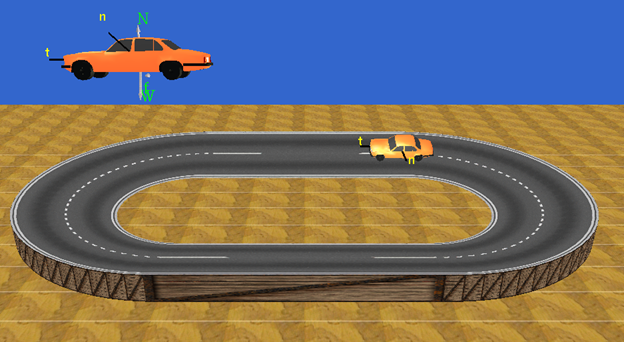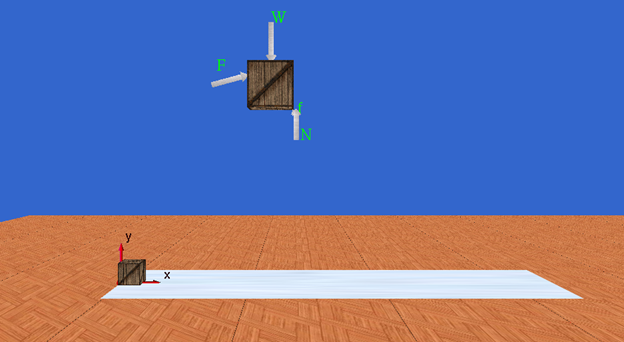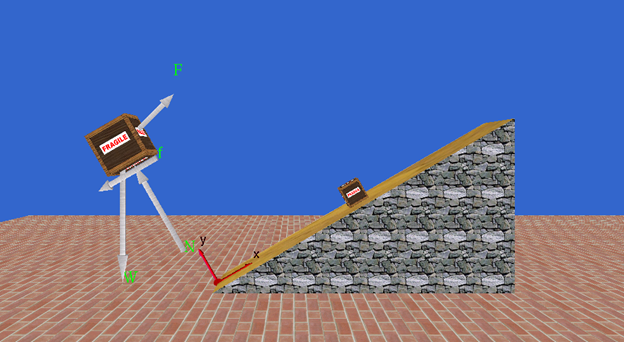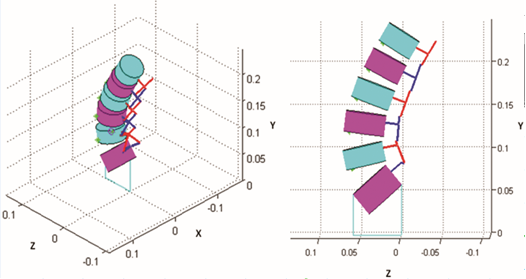- Haptics-Augmented Training Software for Undergraduate Engineering Mechanics
- Simulations vs. Hands-on Lab Experiments for Dynamics Course
- Software Modules for Robotics Education (SMORE)
- Evaluation of Gestural Control in Mobile Robotics
- Biomechanics of the Human Lumbar Spine
** A list of the research projects is given below. You can also visit here to see the Senior Design Projects advised by Dr. Karadoğan.
Haptics-Augmented Training Software for Undergraduate Engineering Mechanics
In collaboration with Ohio University, we are working on a set of software activities and tutorials to augment teaching and learning in standard required undergraduate engineering mechanics courses. Using these software activities, students can change parameters, predict answers, compare outcomes, interact with animations, and feel the results. The overall system aims to increase teaching and learning effectiveness by rendering the concepts compelling, fun, and engaging. The problem with current examples and homework problems is that they are flat, static, boring, and non-engaging, which may lead to student attrition and a less than full grasp of fundamental principles. We implement integration of haptics technology with educational products to enable improvement in undergraduate engineering mechanics education. The current system is composed of a computer (laptop or desktop), a haptic device and a set of haptic modules. Currently, three modules, Crate on the Ramp, Race Car on the Track, and Tip-Proof Crate, were developed and several others are under development.
Simulations vs. Hands-on Lab Experiments for Dynamics Course
Dynamics is a branch of mechanics that deals with the motion of accelerated bodies. It is a versatile subject that allows problems to be handled by multiple methods. This versatility, however, may become a disadvantage to novice learners as they may get overwhelmed with the amount of subject matter covered in a single semester. Mastery of this subject matter may require resources in addition to in-class lectures due to the material that demands higher-order thinking skills. As in most engineering courses, two common methods emerge to supplement the Dynamics course: “Computer-Generated Simulations” and “Hands-on Lab Experiments”. This study aims to compare these two supplemental instruction methods by evaluating the outcome of the exit surveys solicited after the student participants’ practice on the same physical system using both delivery methods. The questions in the exit survey will request participants to rate their level of engagement and the usefulness of each delivery method by means of Likert scales. Open-ended comments will be sought for further development of these delivery methods. The quantitative data will be analyzed by conducting a series of repeated measures t-test. We hypothesize that the hands-on lab experiment will be rated higher in engagement and usefulness for the following reasons: (1) Participants will be actively engaged in the physical manipulation of the objects as opposed to pressing on-screen buttons to indirectly interact with the computer simulation; (2) Real-Life experiments are expected to be perceived more convincing than a software that is running an algorithm with nontransparent specifications, and 3) Participants will be attracted to the state-of-the-art equipment—robotic arms and vision sensors used in today’s popular computer games—in the hands-on experiment.
Software Modules for Robotics Education (SMORE)
This project aims to create and evaluate the SMORE— a collection of interactive tutorials designed to enhance the robotics education of engineering students. This particular software module will train students in defining the three-dimensional geometric relationship between multiple frames of reference that are attached to the links of a robotic manipulator. The problem with current examples and homework problems in robotics is that they are flat, static, and non-engaging, which may lead to student attrition and to a less than full grasp of fundamental principles. The SMORE aim to increase teaching and learning effectiveness by rendering the robotics concepts compelling, fun, and engaging. The system is planned to compose of a computer, a haptic device, and our proprietary software. Broad impact of this project is the potential improvement in teaching and the increased engagement of engineering students in robotics, a popular and demanding STEM subject.
Evaluation of Gestural Control in Mobile Robotics
Devices for human-computer interaction provide developers with numerous ways to interface man and machine. A new generation of such devices can recognize hand gestures as a form of input. Measuring the effectiveness of these devices can be difficult due to the way their performance fluctuates based on the specific application. In this study, we propose a method for comparing the effectiveness of two gesture control devices in a mobile robotics application. The first device, Leap Motion controller, uses infrared point tracking to detect gestures. The second device, Myo armband, uses electromyography and an inertial measurement unit to detect gestures. To compare these two devices, we designed an experiment that requires users to navigate a custom-made mobile robot through an obstacle course using live video feedback from the robot’s camera. The users will navigate the robot using both gesture control devices, and a standard button-operated game controller as the control group. User performance will be evaluated based on: the completion time, accuracy, and precision of navigation. The results will provide insight into the usage of such devices in military applications, search and rescue operations, or any instance where mobile robotics is utilized. We have completed the custom-made robot and can already control it with the Leap Motion controller. The next stage includes incorporation of the Myo armband, and the game controller.
Biomechanics of the Human Lumbar Spine
This paper presents three-dimensional static modeling of the human lumbar spine to be used in the formation of anatomically-correct movement patterns for a fully cable-actuated robotic lumbar spine (RLS) which can mimic in vivo human lumbar spine movements to provide better hands-on training for medical students. The mathematical model incorporates five lumbar vertebrae between the first lumbar vertebra and the sacrum, with dimensions of an average adult human spine. The vertebrae are connected to each other by elastic elements, torsional springs and a spherical joint located at the inferoposterior corner in the mid-sagittal plane of the vertebral body. Elastic elements represent the ligaments that surround the facet joints and the torsional springs represent the collective effect of intervertebral disc which plays a major role in balancing torsional load during upper body motion and the remaining ligaments that support the spinal column. The elastic elements and torsional springs are considered to be nonlinear. The nonlinear stiffness constants for six motion types were solved using a multi-objective optimization technique. The quantitative comparison between the angles of rotations predicted by the proposed model and in the experimental data confirmed that the model yields angles of rotation close to the experimental data. The main contribution is that the new model can be used for all motions while the experimental data was only obtained at discrete measurement points.
The Robotic Lumbar Spine (RLS)
The Robotic Lumbar Spine (RLS) is a 15 degree-of-freedom, fully cable-actuated robotic lumbar spine which can mimic in vivo human lumbar spine movements to provide better hands-on training for medical students. The design incorporates five active lumbar vertebrae and the sacrum, with dimensions of an average adult human spine. It is actuated by 20 cables connected to electric motors. Every vertebra is connected to the neighboring vertebrae by spherical joints. Medical schools can benefit from a tool, system, or method that will help instructors train students and assess their tactile proficiency throughout their education. The robotic lumbar spine has the potential to satisfy these needs in palpatory diagnosis. Medical students will be given the opportunity to examine their own patient that can be programmed with many dysfunctions related to the lumbar spine before they start their professional lives as doctors. The robotic lumbar spine can be used to teach and test medical students in their capacity to be able to recognize normal and abnormal movement patterns of the human lumbar spine under flexion-extension, lateral bending and axial torsion.



.png)


.png)